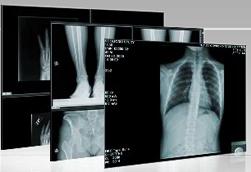Medical imaging is the visualization of body parts, organs, tissues or cells for clinical diagnosis and preoperative imaging. The global medical image processing market is about $15 billion a year. The imaging techniques used in medical devices include a variety of modern equipment in the field of optical imaging, nuclear imaging, radiology and other image-guided intervention. The radiological method, or x-ray imaging, renders anatomical and physiological images of the human body at a very high spatial and temporal resolution.
Dedicated to x-ray instruments, the work of the TULIPP project is highly relevant to a significant part of the market share, in particular through its Mobile C-Arm use case, a medical system that improves surgical efficiency. In real-time, and during an operation, this device displays for the doctor a view of the inside of the patient’s body, allowing the doctor to make small incisions instead of wide cuts and to target the region with more accuracy. This leads to faster recovery times and lower risks of nosocomial disease. The drawback of this technic is the radiation dose, 30 times what we receive from our natural surroundings each day. This radiation is received not only by the patient but also by medical staff carrying out such procedures week in, week out.

While the x-ray sensor is very sensitive, lowering the emission dose increases the level of noise on the pictures, making it unreadable. This can be corrected with proper processing.
From a regulatory point of view, the radiation that the patient is exposed to must have a specific purpose. Thus, each photon that passes through the patient and is received by the sensor must be delivered to the practitioner; no frame should ever be lost. This brings about the need to manage side by side strong real-time constraints and high-performance computing.
We managed to lower the radiation dose by 75% and restore the original quality of the picture thanks to specific noise reduction algorithms running on high-end PCs. However, this is unfortunately not convenient when size and mobility matter, such as in a confined environment like an operating theatre, crowded with staff and equipment.
Yet by bringing the computing power of a PC at the size of a smartphone, TULIPP makes it possible to lower the radiation dose while maintaining picture quality. To achieve this, a holistic view of the system is required so as to achieve the best power efficiency from inevitably highly heterogeneous hardware.
With our power-aware tool chain, the application designer can see, for each mapping of the application tasks on the hardware resources, the impact on power consumption. He or she can thus schedule the processing chain to optimize both the performance and the required energy. The tool chain relies on a low-power real-time operating system. Specifically designed to fit in the small memory sizes of embedded devices, it comes with an optimized implementation of a necessary set of common image processing libraries and allows a seamless scheduling of the application on the hardware chips.






